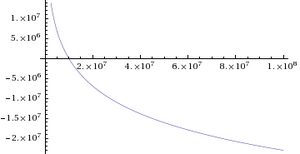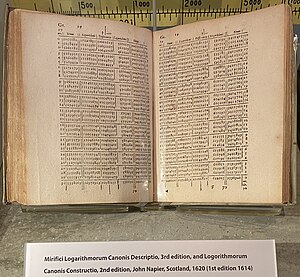This is the current revision of this page, as edited by Skynxnex (talk | contribs) at 13:24, 13 October 2023 (Undid revision 1179895041 by 2601:642:4600:3F80:7C5B:ED3B:67BE:2F38 (talk): even if it's functionally the same as the natural logarithm, it is independently discussed in sources to likely merit an article). The present address (URL) is a permanent link to this version.
Revision as of 13:24, 13 October 2023 by Skynxnex (talk | contribs) (Undid revision 1179895041 by 2601:642:4600:3F80:7C5B:ED3B:67BE:2F38 (talk): even if it's functionally the same as the natural logarithm, it is independently discussed in sources to likely merit an article)(diff) ← Previous revision | Latest revision (diff) | Newer revision → (diff)

The term Napierian logarithm or Naperian logarithm, named after John Napier, is often used to mean the natural logarithm. Napier did not introduce this natural logarithmic function, although it is named after him. However, if it is taken to mean the "logarithms" as originally produced by Napier, it is a function given by (in terms of the modern natural logarithm):
The Napierian logarithm satisfies identities quite similar to the modern logarithm, such as
or
In Napier's 1614 Mirifici Logarithmorum Canonis Descriptio, he provides tables of logarithms of sines for 0 to 90°, where the values given (columns 3 and 5) are
Properties
Napier's "logarithm" is related to the natural logarithm by the relation
and to the common logarithm by
Note that
and
Napierian logarithms are essentially natural logarithms with decimal points shifted 7 places rightward and with sign reversed. For instance the logarithmic values
would have the corresponding Napierian logarithms:
For further detail, see history of logarithms.
References
- Larson, Ron; Hostetler, Robert P.; Edwards, Bruce H. (2008). Essential Calculus Early Transcendental Functions. U.S.A: Richard Stratton. p. 119. ISBN 978-0-618-87918-2.
- Ernest William Hobson (1914), John Napier and the Invention of Logarithms, 1614 (PDF), Cambridge: The University Press
- Roegel, Denis. "Napier's ideal construction of the logarithms". HAL. INRIA. Retrieved 7 May 2018.
- Boyer, Carl B.; Merzbach, Uta C. (1991), A History of Mathematics, Wiley, p. 313, ISBN 978-0-471-54397-8.
- C.H.Jr. Edwards (6 December 2012). The Historical Development of the Calculus. Springer Science & Business Media. ISBN 978-1-4612-6230-5..
- Phillips, George McArtney (2000), Two Millennia of Mathematics: from Archimedes to Gauss, CMS Books in Mathematics, vol. 6, Springer-Verlag, p. 61, ISBN 978-0-387-95022-8.
External links
- Denis Roegel (2012) Napier’s Ideal Construction of the Logarithms, from the Loria Collection of Mathematical Tables.











